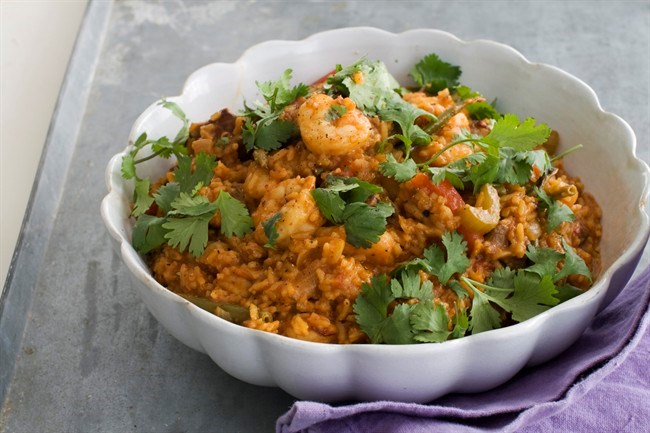Whenever Esi Impraim's mother made jollof — a rich, tomato-laced dish of meats, rice and sometimes seafood — the time it took to bubble away on the stove was always excruciating.
"I always got excited when we had it," the 32-year-old Chicago executive assistant says of the ubiquitous West African staple. "Sometimes she liked to experiment with her dishes, but this one was always the same."
Impraim's parents came to the U.S. from Ghana, and her mom served jollof alongside fish or chicken and went light on the oil. But the dish, popular in countries such as Senegal, Nigeria, Ghana and Liberia, has as many variations as cooks. A one-pot meal, jollof's basic ingredients include rice that turns bright umber in the tomato sauce, spices that range from nutmeg to chili peppers, and sometimes vegetables.
Sound like jambalaya? Not a coincidence.
"If you look at gumbo, jambalaya, hoppin' John, these are all derivatives," says Frederick Douglass Opie, a scholar of foodways of the African diaspora at Harvard University. "As you listen to the definition of what jollof rice is — a red-based rice — it's the same thing. As my mother would say, 'They're all kissing cousins.'"
Jollof rice is thought to have originated in the Jollof empire, a kingdom that controlled wide swaths of western Africa from the 14th through the 19th centuries. Many American slaves came from this part of the continent, part of Africa's "rice belt." They brought with them their agricultural knowledge and their rice-based food traditions.
Like the American dishes it influenced, jollof has endless variations. It is made differently in different countries, and even by different people in the same country. A story in the British newspaper The Guardian called jollof "the African dish that everyone loves but no one can agree on."
Most versions begin by frying onions in oil, adding tomatoes and stock, then cooking the rice in the resulting sauce. But which rice, which spices to add and whether to serve the meat on the side or mixed into the dish can make grandmothers feud. Vegetables — whether or not to include them, let alone which ones to use — are another point of contention. Even the way it's spelled can change.
At Brooklyn, N.Y.'s Joloff Restaurant (yes, spelled differently) owner Papa K. Diagne flavours his tomato sauce with fish stock, as he would in his native Senegal. His fish and vegetables — carrots, cabbage, eggplant, cassava or sweet potato — simmer in the sauce, then get removed and served on the side. The rice cooks in the flavoured tomato broth. Diagne also makes a jollof rice with chicken and a vegetarian version. For all of them, he uses only fine-grained or "broken" jasmine rice.
"I have Asian persons, African-Americans, Africans, I have a variety of customers," Diagne says. "A lot of people come for the jollof rice."
At Lagos Peppersoup Corner at the Intercontinental Restaurant in Columbus, Ohio, Nigerian chef and owner Esther Ajiboye uses only parboiled rice, a rice that is partially cooked in its husk. Her flavourings include curry powder, bouillon cubes, habanero pepper and occasionally ginger. But almost no vegetables.
"The only vegetables I use are onion and red bell pepper," Ajiboye says.
But such disagreements don't make jollof unique. "It's like pizza," Harvard's Opie says. "There's a big argument between Chicago and New York. They've both got the same ingredients, it's just what you do with them.
___
JOLLOF RICE
Start to finish: 45 minutes
Servings: 8
For the rice:
4 tablespoons canola or vegetable oil, divided
1 large yellow onion, chopped
2 cloves garlic, minced
1 tablespoon grated fresh ginger
3 tablespoons tomato paste
15-ounce can crushed or diced tomatoes
1 teaspoon ground coriander
1 teaspoon ground cumin
1 teaspoon curry powder
1 teaspoon salt
1/2 teaspoon ground black pepper
1 teaspoon dried thyme
1/2 teaspoon red pepper flakes (more or less to taste)
2 cups basmati rice
5 to 6 cups (1 1/2 quarts) unsalted chicken stock
For the vegetables (select 2 to 3):
1 red bell pepper, cored and diced
1 green bell pepper, cored and diced
2 stalks celery, diced
2 carrots, diced
3/4 cup fresh or frozen peas
3/4 cup fresh or frozen green beans
For the protein (select 1 or 2):
1 pound large peeled shrimp
1 pound boneless, skinless chicken thighs
1 pound sirloin steak, cubed
1 pound tofu or seitan, cubed
For the garish (select 1):
Chopped fresh parsley
Chopped fresh cilantro
Sliced scallions
Hot sauce
In a large, heavy bottomed pan such as a Dutch oven over medium-high, heat 2 tablespoons of the oil. Add the onion, garlic and ginger, then cook until softened and beginning to brown, about 6 to 7 minutes. Add the tomato paste and continue to cook until the mixture becomes brick red, about another 6 to 7 minutes.
Add the crushed tomatoes, coriander, cumin, curry, salt, black pepper, thyme, red pepper flakes and rice. Stir to mix. Add 5 cups of the chicken stock and bring to a simmer, then cover and cook for 15 to 20 minutes, or until the rice is tender and has absorbed most of the liquid. Check the rice; if it is still firm, add another cup of stock and cook until absorbed.
Meanwhile, in a large saute pan over medium-high, heat 1 tablespoon of the remaining oil. Saute your choice of vegetables for 5 to 6 minutes, or until beginning to brown and starting to be tender. They do not have to be completely cooked through. Add them to the rice and stir in.
Repeat the sauteing process with the remaining tablespoon of oil and your choice of protein, searing it over medium-high heat for 5 to 6 minutes. Stir that into the rice mixture, as well.
Cook until the rice has absorbed all the liquid and the vegetables and protein are cooked through. Season with salt and pepper, to taste, and garnish with herbs and/or hot sauce.
(Recipe by Alison Ladman)



